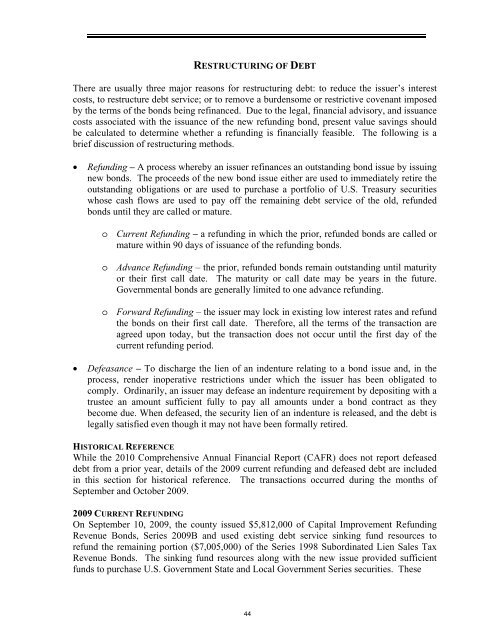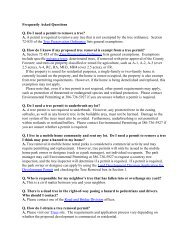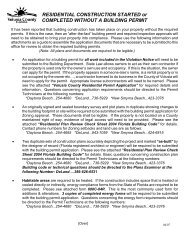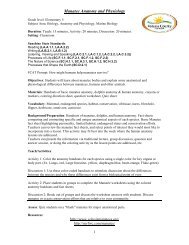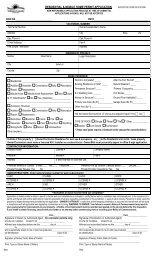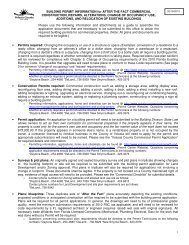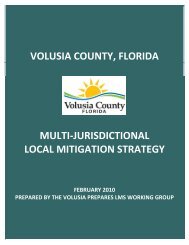2010 Debt Report - Volusia County Government
2010 Debt Report - Volusia County Government
2010 Debt Report - Volusia County Government
You also want an ePaper? Increase the reach of your titles
YUMPU automatically turns print PDFs into web optimized ePapers that Google loves.
RESTRUCTURING OF DEBT<br />
There are usually three major reasons for restructuring debt: to reduce the issuer’s interest<br />
costs, to restructure debt service; or to remove a burdensome or restrictive covenant imposed<br />
by the terms of the bonds being refinanced. Due to the legal, financial advisory, and issuance<br />
costs associated with the issuance of the new refunding bond, present value savings should<br />
be calculated to determine whether a refunding is financially feasible. The following is a<br />
brief discussion of restructuring methods.<br />
• Refunding – A process whereby an issuer refinances an outstanding bond issue by issuing<br />
new bonds. The proceeds of the new bond issue either are used to immediately retire the<br />
outstanding obligations or are used to purchase a portfolio of U.S. Treasury securities<br />
whose cash flows are used to pay off the remaining debt service of the old, refunded<br />
bonds until they are called or mature.<br />
o Current Refunding – a refunding in which the prior, refunded bonds are called or<br />
mature within 90 days of issuance of the refunding bonds.<br />
o Advance Refunding – the prior, refunded bonds remain outstanding until maturity<br />
or their first call date. The maturity or call date may be years in the future.<br />
<strong>Government</strong>al bonds are generally limited to one advance refunding.<br />
o Forward Refunding – the issuer may lock in existing low interest rates and refund<br />
the bonds on their first call date. Therefore, all the terms of the transaction are<br />
agreed upon today, but the transaction does not occur until the first day of the<br />
current refunding period.<br />
• Defeasance – To discharge the lien of an indenture relating to a bond issue and, in the<br />
process, render inoperative restrictions under which the issuer has been obligated to<br />
comply. Ordinarily, an issuer may defease an indenture requirement by depositing with a<br />
trustee an amount sufficient fully to pay all amounts under a bond contract as they<br />
become due. When defeased, the security lien of an indenture is released, and the debt is<br />
legally satisfied even though it may not have been formally retired.<br />
HISTORICAL REFERENCE<br />
While the <strong>2010</strong> Comprehensive Annual Financial <strong>Report</strong> (CAFR) does not report defeased<br />
debt from a prior year, details of the 2009 current refunding and defeased debt are included<br />
in this section for historical reference. The transactions occurred during the months of<br />
September and October 2009.<br />
2009 CURRENT REFUNDING<br />
On September 10, 2009, the county issued $5,812,000 of Capital Improvement Refunding<br />
Revenue Bonds, Series 2009B and used existing debt service sinking fund resources to<br />
refund the remaining portion ($7,005,000) of the Series 1998 Subordinated Lien Sales Tax<br />
Revenue Bonds. The sinking fund resources along with the new issue provided sufficient<br />
funds to purchase U.S. <strong>Government</strong> State and Local <strong>Government</strong> Series securities. These<br />
44


